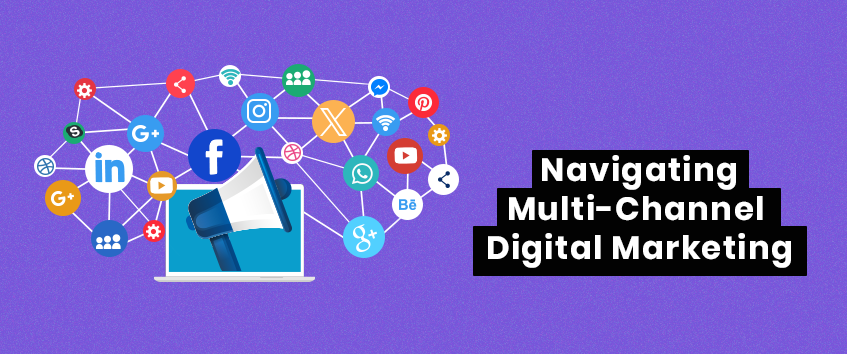Mastering the Multi-Channel Maze: Strategies for an Effective Digital Marketing Approach
May 31, 2024
In today’s digital age, the marketing landscape is more fragmented than ever. As consumers interact with brands across a myriad of digital touchpoints—from social media and websites to email campaigns and mobile apps—it has become essential for businesses to adopt an omnichannel approach to digital marketing. This strategy goes beyond merely maintaining a presence on multiple platforms; it involves creating a seamless integration across all channels, thereby providing a consistent, engaging, and personalised customer experience.
The necessity for an omnichannel strategy stems from the evolving behaviour of consumers who no longer follow a linear path to purchase. Instead, their journey is complex and multidimensional, hopping from one channel to another, sometimes simultaneously, as they progress towards making a purchase decision. For instance, a potential customer might see a product on an Instagram ad, research it on a company’s website, read reviews on a third-party site, and finally make the purchase in-app. If any of these touchpoints fail to provide a consistent message and user experience, there is a significant risk of losing that customer to a competitor.
Given the diversity of platforms available, one of the first steps in mastering the multi-channel maze is to understand where your target audience spends their time and how they prefer to engage with content. Data analytics tools can provide insights into consumer behaviour and help pinpoint which channels are most effective for reaching your demographic. With this information, businesses can craft tailored content that resonates with their audience on each specific platform.
Another critical element is the integration of these channels to deliver a cohesive brand experience. This means ensuring that all marketing communications reflect the same brand values, tone, and messaging. Technologies such as Customer Relationship Management (CRM) systems and marketing automation tools play a pivotal role in this integration, enabling businesses to maintain a unified view of the customer across all platforms.
However, achieving a seamless omnichannel experience is not just about technology and data. It also involves a shift in company culture and processes. Silos within the organisation must be broken down, and teams across different departments need to work collaboratively towards a common goal. This integrated approach ensures that every customer interaction is informed by a comprehensive understanding of their preferences and previous engagements with the brand.
Moreover, an effective omnichannel strategy is adaptive. Digital marketing is a dynamic field, with new platforms, technologies, and consumer trends continually emerging. Businesses must remain agile, ready to tweak their strategy in response to these changes or risk falling behind. This means regularly revisiting and revising their approach to ensure it remains relevant and effective.
While channels like Google and Facebook dominate the digital advertising world, it’s crucial for a Digital Marketing Agency in Kerala to explore lesser-known platforms that may offer valuable opportunities to connect with specific segments of your audience. Platforms like TikTok or niche online forums can be particularly effective for targeting younger demographics or specific interest groups. Navigating the multi-channel maze requires a well-thought-out strategy that considers the complexities of modern consumer journeys. By adopting an omnichannel approach, businesses can create a more robust and engaging brand presence that meets customers wherever they are in their buying journey, thus enhancing the overall customer experience and ultimately driving greater loyalty and sales.
The Multi-Channel Opportunity
Digital marketing has evolved far beyond the confines of traditional search engines. Today’s landscape includes a vast array of channels, each offering unique opportunities to amplify your brand’s voice and connect with different segments of your audience. Social media platforms, email marketing, mobile apps, and even emerging digital spaces like virtual reality (VR) and augmented reality (AR) form part of a comprehensive multi-channel mix. Here’s a closer look at how businesses can leverage these channels effectively to maximise their marketing impact.
Social Media Mastery:

Social media is indispensable for brand engagement in the modern digital era. Each platform, be it Instagram, Twitter, LinkedIn, or Facebook, serves a unique demographic and caters to specific content preferences. For instance, Instagram is ideal for visually compelling content, while LinkedIn is more suited for professional articles and company updates. By tailoring your content to suit the platform’s strengths and audience preferences, you can enhance engagement significantly. Utilising robust analytics tools allows marketers to gauge what type of content resonates most, enabling them to fine-tune their strategies to foster deeper community interaction and brand loyalty. Moreover, social media ads can be targeted very precisely, from demographic details to interests, ensuring that your message reaches the most receptive audience.
Email Marketing Efficiency:

Despite the rise of new platforms, email marketing continues to offer one of the highest returns on investment. The key to email marketing success lies in personalization and segmentation. By segmenting your audience based on behaviours, preferences, and past interactions, you can craft messages that are tailored to the needs and interests of specific groups. This targeted approach not only enhances engagement but also significantly increases the chances of conversions. Furthermore, email marketing tools provide sophisticated tracking and analytics, enabling marketers to refine their campaigns based on real-time feedback and behavioural data.
Expanding to New Realities:
VR and AR are reshaping the way brands interact with their consumers by offering immersive experiences that are both memorable and engaging. These technologies have found applications across various sectors such as real estate, retail, and education. For example, real estate companies can offer virtual tours of properties, allowing potential buyers to explore homes from the comfort of their own. Retailers can use AR to let customers try products virtually before making a purchase decision. In education, VR can transform conventional learning environments into interactive and engaging experiences. While these technologies are still emerging, they represent a powerful tool in the digital marketer’s arsenal, particularly for campaigns aiming to create a strong impression or provide an interactive experience.
Integrated Mobile Experiences:
Mobile apps provide a direct pathway to consumer engagement, thanks to the ubiquity of smartphones. Apps can offer functionalities that websites cannot, such as push notifications and location-based services, making them a vital part of the digital marketing ecosystem. For businesses, mobile apps are an excellent way to maintain continuous engagement, provide utility, and gather valuable user data. When integrated with other marketing channels, mobile apps can support a unified brand experience, driving both engagement and loyalty.
In conclusion, mastering the multi-channel digital marketing landscape requires a strategic approach that respects the strengths and audience of each platform. By leveraging social media for engagement, email for precision targeting, VR and AR for immersive experiences, and mobile apps for continuous interaction, businesses can create a powerful, integrated marketing strategy that meets the diverse needs of their audience, enhances their brand presence, and drives meaningful results.
Integrating Channels for a Cohesive Strategy
The essence of a successful omnichannel strategy lies in the seamless integration of various marketing channels to deliver a unified brand message that resonates with consumers across different platforms. Achieving this integration demands a blend of coherent messaging, data-driven decisions, and robust technological support. Here’s a detailed look at how businesses can build a cohesive and efficient omnichannel marketing strategy.
Unified Messaging:

A consistent and unified message is crucial for establishing a strong brand identity. Your core brand message should be coherent and flexible enough to adapt fluidly from one platform to another, ensuring it resonates well with the specific features and user base of each channel. For example, while your message might be more informal and visually driven on Instagram, the same core message can be adapted into a more professional and detailed version for LinkedIn audiences. This adaptability helps in maintaining a recognizable brand identity irrespective of the channel, making your brand easily identifiable and reinforcing your message across different touchpoints. Consistency in your messaging not only builds trust but also enhances brand recall, which is vital in a competitive market.
Data-Driven Decisions:

In today’s digital marketing environment, decisions need to be anchored in solid data. Utilising analytics tools to gather and analyse data from all your channels allows you to gain deep insights into customer behaviour, preferences, and engagement patterns. This wealth of information should be the cornerstone of your marketing strategy, enabling you to tailor your approach to effectively reach different audience segments. For instance, data can reveal which types of content perform best on which platforms, at what times users are most active, and how different segments react to various marketing messages. This information allows marketers to optimise their strategies, ensuring that they are not only reaching their audience but also engaging them in the most effective way possible.
Technological Integration:
Investing in the right technology is crucial for bridging the gap between different platforms and facilitating a smooth flow of information. Tools like Customer Relationship Management (CRM) systems, marketing automation software, and content management systems (CMS) are integral to a seamless omnichannel strategy. A CRM system can help you maintain a unified view of each customer’s interactions across all channels, from social media to email to phone conversations. This integration allows for more personalised and targeted marketing efforts, enhancing customer engagement and satisfaction. Marketing automation tools can help in scheduling and deploying marketing messages efficiently across various channels, ensuring that the right message reaches the right audience at the right time. Meanwhile, a robust CMS can ensure that your content is consistent and up-to-date across all platforms, reinforcing your unified brand message.
Strategic Implementation:
The final piece of the puzzle is the strategic implementation of these components. This involves not only setting up the systems and processes but also continuously monitoring and refining them. Regular audits of your omnichannel strategy will help identify any discrepancies or opportunities for improvement. Training your team to understand and effectively use these tools is equally important, as their expertise will directly influence the success of your marketing efforts. Integrating your marketing channels into a cohesive strategy is not just about using the right tools but also about creating a consistent brand experience that is personalised and engaging. By focusing on unified messaging, leveraging data-driven insights, and investing in the right technology, businesses can enhance their engagement with customers and build a stronger, more recognizable brand across multiple digital platforms.
Navigating the Future of Digital Marketing

As the digital landscape continues its rapid evolution, the adaptability and forward-thinking of our marketing strategies become increasingly crucial. The future of digital marketing is not just about being present on a variety of platforms but integrating these into a cohesive, omnichannel strategy that engages customers at multiple touchpoints effectively and consistently.
The key to mastering this dynamic field lies in understanding the broad spectrum of available channels—from established giants like Google and Facebook to emerging platforms in social media, virtual reality, and beyond. Each channel offers unique opportunities to connect with diverse audience segments, making it essential for marketers to develop a deep understanding of where their target audiences spend their time and how they prefer to engage.
Embracing new technologies and platforms enables marketers to create more dynamic, personalised, and effective marketing campaigns. For instance, leveraging advanced data analytics can provide insights into consumer behaviour and preferences, allowing for more targeted and relevant marketing efforts. Meanwhile, technologies such as AI and machine learning are revolutionising the way we can automate and optimise these interactions, making campaigns more efficient and impactful.
Navigating the multi-channel world may seem daunting, but it presents a plethora of opportunities to connect with your audience in meaningful ways, especially for a Digital Marketing Agency in Kochi. The goal extends beyond mere visibility; it’s about creating a consistent and engaging customer journey across all digital touchpoints. This requires not only strategic integration of various marketing channels but also a consistent message that resonates with your audience, regardless of the platform.
The future of digital marketing demands flexibility, innovation, and a holistic view of the consumer’s online experience. By strategically embracing the full array of digital channels and technologies, marketers can craft impactful, engaging campaigns that not only reach but resonate with a diverse and dynamic audience. This approach isn’t just about keeping up with trends; it’s about setting them, ensuring your brand not only adapts to the future but helps shape it.
